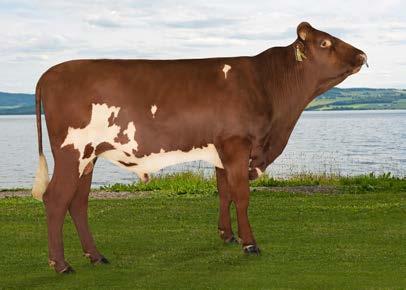NORWEGIAN RED SIRES















Ranheim x Birkelund x Svantesvol




Sire: RANHEIM 11851
Dam: 1140

• #1 Health Weighted Index (HWI)
• #2 Mastitis resistance
• #3 Daughter fertility
• Outstanding udders

Breeder: May Hilde Hjelmeland & Terje Torgersen, 6869 Hafslo
























































































Roen x Reitan 2 x Velsvik



























SAUSVATN PP
SKJEFSTAD PP BRUMUNDDAL PP TORNES PP
PP
PP
PP
PP
PP



Bull ID: 252NR12139 NASIS: 85UUS05







Sire: AGHOLT 11942 Dam: 427

• Only NR that is BB Kappa Casein
• Improves daughter fertility
• High components and calving ease




















• Breed leading daughter fertility proven in Aust and Norway
• Improves feet and legs
• High protein kgs

















• Short gestation at -11 days
• High daughter fertility
• Highest Aust proven homozygous polled Aussie Red












85UUT04





Sire: OKSTAD P 12033
Dam: AUGUSTINE 682

NR OKSTAD PP
• Improves daughter fertility
• Great milking speed and temperament
• Increased strength and body







ELSA 577 Breeder: Ole H. Okstad, 7075 Tiller
















































• TMI (Total Merit Index) is used to identify the best Norwegian Red bulls to become elite sires for use throughout Norway.
• 14 traits and indexes are grouped into an index called TMI, with production, udder health, udder conformation, and fertility indexes receiving the highest relative weights within the TMI.
• The relative weights in the current TMI give optimal genetic response for all important traits in the Norwegian Red breeding goal.
No. of inseminations, heifers
No. of inseminations, cows
Calving to first insemination (CFI)
Calving ease, direct
Clinical mastitis
Somatic cell count (SCC)
Feed$aved™
Body weight
Lact 1
Number of inseminations in heifers until pregnant
Number of inseminations in cows until pregnant
Days from calving to first insemination for lact 1-4 (days)
No calving problems when bred to 1st lact heifers (%)
Lact 1-3 daughters not treated for clinical mastitis (%) SCC for lactation 1-3 daughters (cells/ml)
E.G. Milk Production: the average kg of milk for lactations 1-3 is 8,144kg (17,955 lbs.). For Milk yield=112 expect +274kg (604 lbs.) for total milk yield of 8,418kg (18,559 lbs.) per lactation.
E.G. Stature: average 1st lactation cows have rump height of 136.8 cm (53.9”). For a bull with Stature=112 expect an average daughter to be 1.13 cm (0.44”) taller. For Stature=88 an average daughter would be 1.13 cm (0.44”) shorter.
E.G. Calving ease: 88.0% of calvings of 1st lactation heifers, attributed to sire of calf, have no difficulty. For a bull with direct calving ease=112 expect 3.5% better or 91.5% of calvings of 1st lactation heifers with no calving difficulty due to sire of calf.


Skjelvan x Eggtroen P
Enger x Garvik
Nymoen P x Eik
Ponnistus x Olstad
Jo-Onstad P x Ofstad P
Dalsbygda P x Myra
Saur PP x Holmas
Udder conformation index20.5% of TMI
• The udder conformation index consists of nine traits viewed from the exterior of the cow. These udder traits are weighted in such a way that a high score for udder index reflects a durable and functional udder.
• Udder conformation traits are scored by breeding advisors using a linear scale. The udder trait definitions are harmonized with definitions for dairy cattle populations in other countries.
The udder conformation index consists of:
Udder depth
Front teat placement
Rear teat placement
Temperament index0.5% of TMI
• This trait is scored by farmers on first-lactation heifers and is reported to the Norwegian Dairy Herd Recording System. They use a scale of 1 to 3, where 1 is easy, 2 is average and 3 is uneasy.
• The Norwegian Red is likely the most fertile breed of dairy cattle in the world due to sustained selection for increased fertility for over 40 years.
• The fertility index was recently improved by replacing non-return rate with number of inseminations. Number of inseminations is biologically very similar to non-return rate, but it has more genetic variation since cows requiring more inseminations are penalized more heavily than cows with just one unsuccessful insemination.
• Udder health (mastitis) causes the greatest economic losses of any disease in dairy cattle. The Norwegian Red now has a low frequency of clinical mastitis (CM) due in part to genetic progress in resistance to mastitis.
• SCC is the 305-day lactation geometric mean of SCC.
• Somatic cell count (SCC) and CM are highly correlated genetically, meaning that selection for SCC (the trait with higher heritability) will result in indirect selection for CM (each are influenced by some of the same genes). A low incidence of clinical mastitis makes it important to include SCC from an economic standpoint and, also, for indirect selection to continue to improve clinical mastitis resistance.
The udder health index consists of:
•
Calving ease index2.9% of TMI
• The frequency of calving difficulty in the Norwegian Red population is very low compared to other breeds.
• Paternal calving ease (calving ease attributed to sire of calf) was recently added to maternal calving ease (how daughters of a bull perform when they calve) to make up the calving ease index.
• Long-term selection for calving ease since 1978 has resulted in a low frequency in calving difficulty even though the two calving ease traits have low heritability.
• Rump angle is an important trait related to calving difficulties. With the move to GS, maternal calving ease has a lower reliability compared to reliability under the progeny test program. The indirect information on rump angle in TMI now adds significantly to the accuracy for selection to improve maternal calving ease.
The calving ease index consists of:
Calving ease,
• Breeding advisors record foot and leg conformation traits together with other conformation traits. These
and rear legs
foot & leg conformation index consists


Matt.Aikenhead@genusplc.com
Rex.Barry@genusplc.com
Alan.Blum@genusplc.com
Gerard.Eccles@genusplc.com
Brian.Enbom@genusplc.com
Shane.Gardiner@genusplc.com
Kim.Hodder@genusplc.com
Gerard.Eccles@genusplc.com
Rebecca.Phelan@genusplc.com
Marcus.Rees@genusplc.com